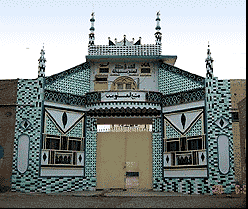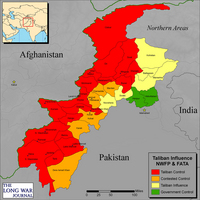|
|
|
The front gate of the Haqqani-run Manba Ulom madrassa in North Waziristan. Photo by The Asia Times. |
The US has attacked a safe house in the lawless, Taliban-controlled tribal agency of North Waziristan.
An unmanned Predator aircraft fired at least one Hellfire missile at a compound in the town of Data Khel just outside of Miramshah. The strike hit the home of a Taliban leader named Tariq Khan.
Thirteen people were reported killed, including “foreigners,” according to Geo News. The term foreigner is often used to describe Arab and other non-Pakistani al Qaeda members sheltering in Pakistan’s northwest. No senior Taliban or al Qaeda leaders have been reported killed in the attack.
The al Qaeda-linked Haqqani family and Taliban warlord Hafiz Gul Bahadar operate in North Waziristan. The Haqqani Network has a strong presence in the Miramshah region of North Waziristan.
Today’s attack is the thirteenth inside Pakistan this year and follows a strike against a Taliban safe house and training camp in the Arakzai tribal agency just three days ago. A senior al Qaeda operative and three other Arab fighters are reported to have been among the 12 killed in the first attack in Arakzai since the US began launching airstrikes in northwestern Pakistan since 2004.
Targeting the Haqqani Network
The US has been heavily targeting the Haqqani Network in Pakistan and across the border in Afghanistan since early 2008. More than half of the US strikes have hit targets in North Waziristan.
“We want the Haqqanis to know we will hit them anywhere,” a senior US military intelligence official told The Long War Journal after the Sept. 8 strike on the Haqqani madrassa.
The Manba Ulom madrassa was established by Jalaluddin Haqqani, the family patriarch who has close ties with Osama bin Laden. The madrassa was used in the 1980s to train mujahideen to fight the Soviet Union in Afghanistan. The Haqqani family used the Manba Ulom madrassa as a training center and meeting place for senior al Qaeda leaders after the US invasion of Afghanistan in 2001.
The Pakistani government closed the madrassa down in 2002, but it was reopened in 2004. Since then, Taliban fighters and members of al Qaeda’s network are known to shelter in the madrassa compound.
The madrassa serves as the headquarters for the Haqqani Network, while the forward operating command center in Afghanistan is located in the village of Zambar in the northern Sabari district in Khost province, Afghanistan. The network is active in the Afghan provinces of Khost, Paktia, Paktika, Ghazni, Logar, Wardak, and Kabul, and provides support to Taliban networks in Kunar, Nangarhar, Helmand, and Kandahar provinces
The Haqqanis have extensive links with al Qaeda and Pakistan’s military intelligence agency, the Inter-Service Intelligence, or ISI. This relationship has allowed the Haqqani network to survive and thrive in North Waziristan. The Haqqanis control large swaths of North Waziristan, and run a parallel administration with courts, recruiting centers, tax offices, and security forces.
Siraj Haqqani, a son of Jalaluddin, has risen in prominence over the past two years. He is believed to be the mastermind of the most deadly attacks inside Afghanistan as well as the senior military commander in eastern Afghanistan. The US military has described Siraj as the primary threat to security in eastern Afghanistan. On March 25, the US Department of State put a $5 million bounty out for information leading to the capture or conviction of Siraj.
Siraj is believed to be dangerous not only for his connections with the Afghan Taliban, but with al Qaeda’s central leadership. His connections extend all the way to Osama bin Laden. Siraj actively recruits foreigners into the network and trains them to conduct suicide attacks in Afghanistan.
Suicide attack targets military convoy in North Waziristan
The Taliban attempted to strike back at the Pakistani military in revenge for the US strikes in North Waziristan. A suicide bomber targeted a military checkpoint outside a Frontier Corps base in Miramshah.
Members of the Frontier Corps fended off the attack by firing on the suicide car bomber. The bomb detonated before it could hit the checkpoint, and killed ten Pakistani civilians, Dawn reported. Geo News reported that 17 civilians, including five children, were killed in the attack.
The Taliban have threatened to target Pakistani security forces in retaliation for aiding the US in conducting its Predator campaign. The military and the Taliban currently maintain a truce in North and South Waziristan. This truce allows the Taliban to run the tribal agencies.
Baitullah Mehsud claims credit for murder spree in New York
Baitullah Mehsud, the leader of the Pakistani Taliban, has also threatened to attack the united States in revenge for the Predator strikes in North and South Waziristan.
“Very soon we will take revenge from America, not in Afghanistan but in Washington, which will amaze the entire world,” Baitullah threatened last week after taking credit for a series of deadly attacks in Pakistan, including the military assault on a police training center in Lahore.
Baitullah claimed credit for yesterday’s deadly shooting spree at an immigration services center in Binghamton, New York. A man entered the facility and killed 13 people before turning his gun on himself.
“I accept responsibility,” Baitullah told Reuters. “They were my men. I gave them orders in reaction to US drone attacks.” Baitullah claimed a Pakistani man and another man were behind the attacks.
But Baitullah’s claim appears to be false. There appears to have been only one attacker, who was a Vietnamese immigrant who recently lost his job.
Background on US strikes against al Qaeda and Taliban networks in northwestern Pakistan
|
Click map for full view. Taliban presence, by district and tribal agency, in the Northwest Frontier Province and the Federally Administered Tribal Agencies. Information on Taliban presence obtained from open source and derived by The Long War Journal based on the presence of Taliban shadow governments, levels of fighting, and reports from the region. Map created by Bill Raymond for The Long War Journal. |
US intelligence believes that al Qaeda has reconstituted its external operations network in Pakistan’s lawless, Taliban-controlled tribal areas. This network is tasked with hitting targets in the West, India, and elsewhere. The US has struck at these external cells using unmanned Predator aircraft and other means in an effort to disrupt al Qaeda’s external network and decapitate the leadership. The US has also targeted al Qaeda-linked Taliban fighters operating in Afghanistan, particularly the notorious Haqqani Network.
As of last summer, al Qaeda and the Taliban operated 157 known training camps in the tribal areas and the Northwest Frontier Province. Al Qaeda has been training terrorists holding Western passports to conduct attacks, US intelligence officials have told The Long War Journal. Some of the camps are devoted to training the Taliban’s military arm; some train suicide bombers for attacks in Pakistan and Afghanistan; some focus on training the various Kashmiri terror groups; some train al Qaeda operatives for attacks in the West; some train the Lashkar al Zil, al Qaeda’s Shadow Army; and one serves as a training ground for the Black Guard, the elite bodyguard for Osama bin Laden, Ayman al Zawahiri, and other senior al Qaeda leaders.
There were 36 recorded cross-border attacks and attempts in Pakistan during 2008, according to numbers compiled by The Long War Journal. Twenty-nine of those attacks took place after Aug. 31. There were only 10 recorded strikes in 2006 and 2007 combined.
During 2008, the US strikes inside Pakistan’s tribal areas killed five senior al Qaeda leaders. All of the leaders were involved in supporting al Qaeda’s external operations directed at the West.
Abu Laith al Libi, a senior military commander in Afghanistan, was killed in a strike in North Waziristan in January 2008.
Abu Sulayman Jazairi, al Qaeda’s external operations chief, was killed in a strike in Bajaur in March 2008.
Abu Khabab al Masri, al Qaeda’s weapons of mass destruction chief, and several senior members of his staff were killed in a strike in South Waziristan in July 2008.
Khalid Habib, the leader of al Qaeda’s paramilitary Shadow Army, was killed in a region controlled by Baitullah Mehsud in South Waziristan in October 2008.
Abu Jihad al Masri, the leader of the Egyptian Islamic Group and member of al Qaeda’s top council, was also killed in North Waziristan in October 2008.
In 2009, US strikes have killed two senior, long-time al Qaeda leaders. Osama al Kini and his senior aide, Sheikh Ahmed Salim Swedan, were killed in a New Year’s Day strike in South Waziristan. Kini was al Qaeda operations chief in Pakistan. Both men were behind the 1998 bombings of the US embassies in Dar es Salaam, Tanzania, and Nairobi, Kenya, which killed 224 civilians and wounded more than 5,000 others.
US attacks inside Pakistan during 2009:
• US strikes Haqqani Network in North Waziristan
April 4, 2009
• US launches first strike in Arakzai tribal agency
April 1, 2009
• Latest US strike targets al Qaeda safe house in North Waziristan
March 26, 2009
• US airstrike kills 8 in Baitullah Mehsud’s hometown
March 25, 2009
• US launches second strike outside of Pakistan’s tribal areas
March 15, 2009
• US missile strike in Kurram agency kills 14
March 12, 2009
• US airstrike kills 8 in South Waziristan
March 1, 2009
• US airstrike in Pakistan’s Kurram tribal agency kills 30
Feb. 16, 2009
• US Predator strike in South Waziristan kills 25
Feb. 14, 2009
• US strikes al Qaeda in North and South Waziristan
Jan. 23, 2009
• US hits South Waziristan in second strike
Jan. 2, 2009
• US kills 4 al Qaeda operatives in South Waziristan strike
Jan. 1, 2009
For a summary of US strikes inside Pakistan in 2008, see US strikes in 2 villages in South Waziristan.










6 Comments
More detail, although sketchy, is now available about the missile strike.
AFP: Suspected US strike kills 13 in Pakistan
Bill links to an article on his main page about how the Pakistani intelligence establishment has reached an agreement with the U.S. to target Baitullah Mehsud. But you have to believe that if they are willing to provide that type of intelligence, they are probably also willing to provide targeting intelligence on many other militants and ‘foreigners’.
Daily Telegraph: Pakistan ‘helps US drone attacks’
This guys comfort zone has to be shrinking. If the P-stani’s [who know more than they let on] would provide the intel, its only a matter of time. Dead man walking.
Good shooting. Keep it up, boys!
Bill,
What do you make of all these recent reports of UBL in Iran?
GOOD WORK TROOPS!!!
Good work, hope they will kept it up